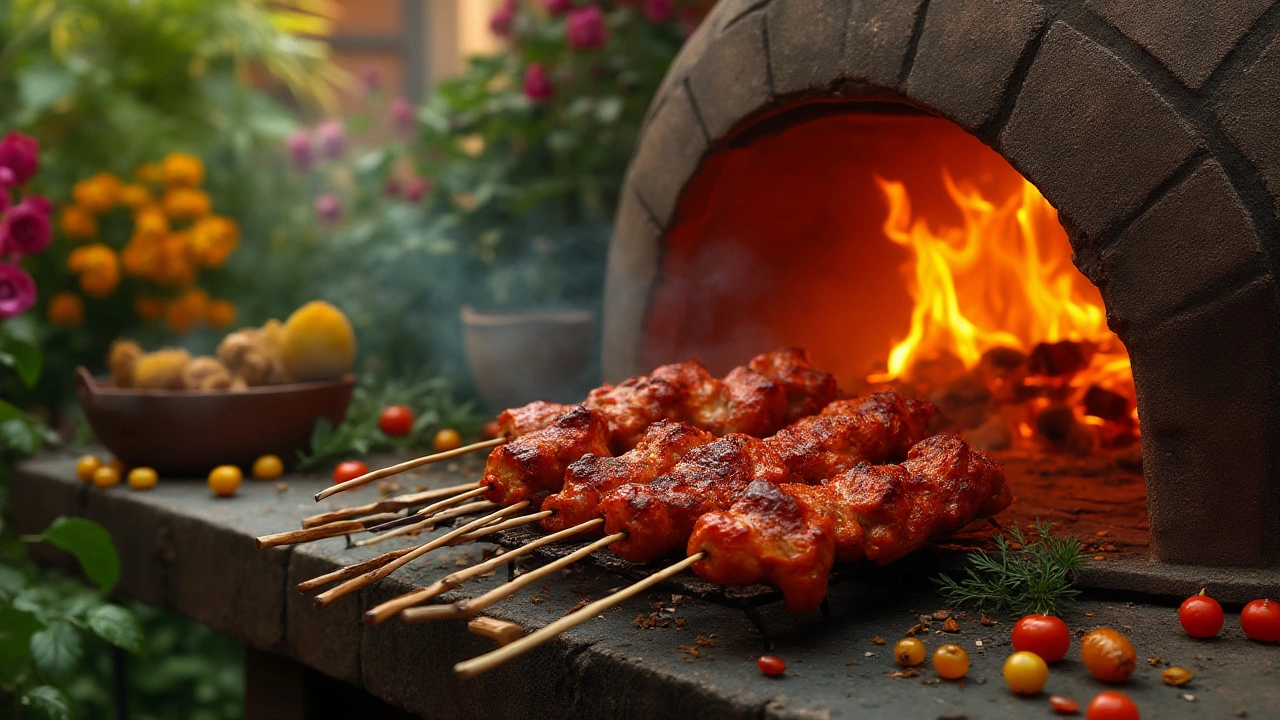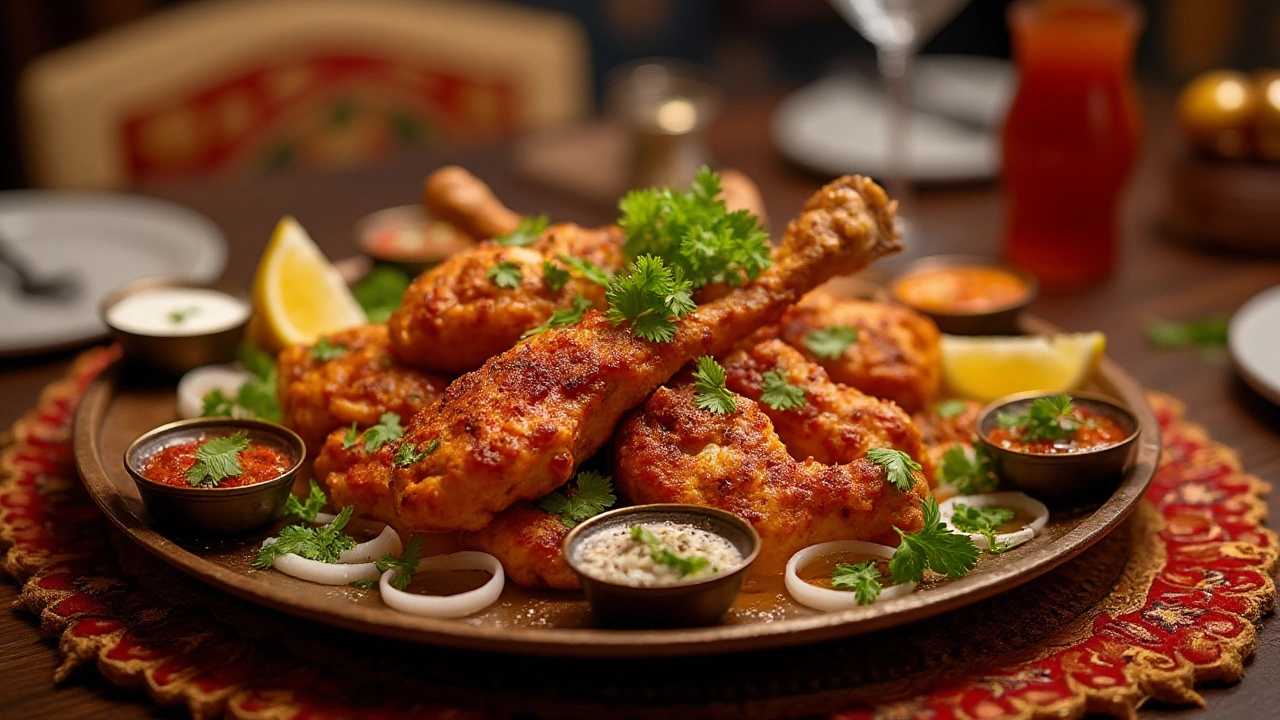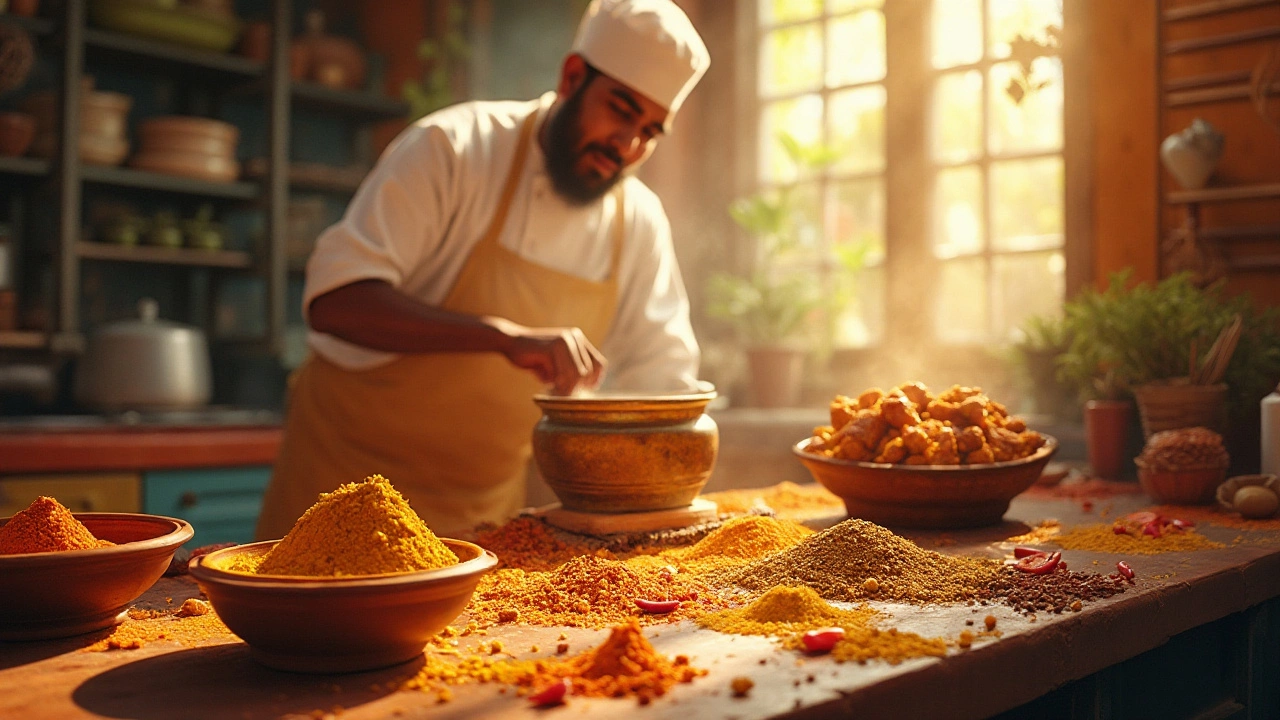Tandoori chicken is a culinary marvel that intrigues both the curious and the seasoned food lover. With its mouth-watering blend of spices and engaging aroma, it's a dish that transcends cultures and regions, finding a place on menus across the globe.
The magic starts with the marinade, a joyous concoction of yogurt and a symphony of spices like cumin, coriander, and the distinct red-hued Kashmiri chili powder that gives the chicken its signature color. But it's not just about the ingredients—it's about the waiting, allowing the flavors to meld and penetrate each fiber of the chicken.
The real wonder comes alive when the chicken meets the tandoor, a clay oven where intense heat and smoky flavors create that unmatched charred exterior and juicy bite. Without the indulgence of this process, tandoori chicken would just be an impersonation of what it could be.
In this article, you'll not only learn the steps for crafting this iconic dish but also discover the culinary heritage that makes tandoori chicken a masterpiece of Indian cuisine.
- The Origins of Tandoori Chicken
- Essential Ingredients and Spices
- The Art of Marination
- Cooking Techniques and Tips
- Serving Suggestions and Pairings
The Origins of Tandoori Chicken
The journey of tandoori chicken is one that traverses centuries, reflecting the vibrant culture and rich history of India. This beloved dish finds its roots in the Punjab region, where it was originally cooked for royal gatherings and festive occasions. The discovery of this culinary marvel is attributed to Kundan Lal Gujral, a pioneering restaurateur in the 1920s, who went on to popularize it at the now-legendary restaurant, Moti Mahal, in Delhi. By infusing the chicken with a rich blend of spices and cooking it in a tandoor—a traditional clay oven heated to high temperatures—he introduced an unmatched culinary experience to the world.
The tandoor itself, a powerhouse of culinary invention, traces back to ancient times, its existence documented in the Harappan civilization over 5,000 years ago. The earthen oven, strategically constructed to retain heat, transformed how food was cooked, leaving it juicy inside with a crispy finish. It was used to bake breads like naan and roti, but Kundan's innovative spirit saw the potential in using it for meats, giving birth to the smoky and succulent tandoori chicken.
With post-partition migrations, this dish traveled far beyond India's borders, capturing the imagination of global palates. It became a symbol of Indian cuisine, celebrated for its simplicity yet deep flavors. In South Asia, it is more than a mere dish; it's an embodiment of cultural heritage and hospitality. Tandoori chicken's adaptability and irresistible taste soon cemented its place in international cookbooks and restaurant menus. As Indian communities flourished abroad, so did their culinary traditions, forever altering the food landscape around them.
"Tandoori chicken represents India's culinary diplomacy at its best, challenging palates across the globe," writes Madhur Jaffrey, a celebrated food writer, in her analysis of Indian culinary influence.
Modern incarnations of this ancient dish stay true to their roots yet have inspired countless variations. Today, amidst a bustling food scene, tandoori chicken continues to evolve, influencing street food vendors and high-end chefs alike, each bringing their twist while maintaining the essence that made it famous. It's a testament to the fact that while innovative techniques and flavors emerge, the traditional has an unshakeable place in the hearts of food enthusiasts worldwide. Understanding the origins of tandoori chicken offers a window not only into history but also into the incredible journey of a dish that continues to unite and inspire cultures everywhere.
Essential Ingredients and Spices
The soul of tandoori chicken lies in its anointment with a mixture of carefully selected flavorful spices and components. Each plays its part like an essential note in a melody. At the heart of this aromatic composition is yogurt, serving not only as the base for the marinade but as a tenderizer, ensuring the chicken remains succulent through the cooking process. It forms the creamy canvas upon which the vibrant hues of spices paint their tale. Antimicrobial, it encourages the absorption of flavors and acts as a pacifying agent when the spices come alive with heat.
The spices, oh the spices! They pour into the mixture with gusto, infusing the yogurt with their pungency. Cumin, with its warm flavor, is like the earth — grounding, giving depth. Then comes coriander, sprinkling its citrus whisper through the air. The commanding blend cannot do without the vibrant Kashmiri red chili powder. Although it appears fiery, it isn’t overwhelmingly hot but rather gifts the chicken its majestic red hue. Garam masala waltzes in later, a blend within a blend, introducing a complex layering of spices including cloves and pepper.
Let us not ignore the role of fresh ingredients: ginger and garlic pasted together into a dance of their own, kissing the chicken with a touch of pungent euphoria. Lemon juice is essential, with its tartness cutting through the creamy marinade. It’s not just about flavor; acid balance is crucial here, encouraging flavors to nestle gently into the chicken, each morsel imbued with character. In the words of Chef Sanjeev Kapoor, a celebrated Indian chef,
"The magic isn’t just in the spices; it’s about how they mingle with the base and each other to create a harmony that coats every piece of meat, igniting the senses."
If one endeavors to understand the essence, it’s also beneficial to glance at the science. Here's where paprika can play a substitute role, within a table of integration options for global cooks, illustrating the adaptability.
| Spice | Flavor Profile | Alternative |
|---|---|---|
| Kashmiri Chili | Mild, Red Hue | Paprika |
| Cumin | Warm, Earthy | Coriander |
| Garam Masala | Complex, Warm | Allspice |
This table showcases the ingenuity home cooks might employ to recreate the authentic aroma even when certain spices are unavailable. What persists, regardless, is the significance of the right balance. It's this balance that ensures each ingredient plays its part solo and in harmony, offering a coherent symphony that is the essence of unforgettable tandoori chicken.

The Art of Marination
The journey to unlocking the flavorful depths of tandoori chicken begins with the art of marination. This ancient technique is more than just a prelude to cooking; it’s an essential step that imparts the intense taste and tantalizing aroma associated with this beloved dish. At its core, the marinade for tandoori chicken is a well-crafted balance of spicy, tangy, and creamy elements, each playing a crucial role in the alchemy of flavors. The journey starts by choosing superior quality spices, with cumin, coriander, garlic, and ginger taking center stage. These are harmoniously blended with a generous amount of yogurt, which not only tenderizes the meat but also subtly imbues it with a rich tang. The use of Kashmiri chili powder is indispensable, lending the chicken its characteristic vibrant red color without overwhelming the palate with heat.
The most intriguing aspect of marinating is the patience it commands from the cook. Allowing the chicken to rest in this aromatic concoction, often for several hours or overnight, ensures that each morsel is deeply infused with flavor. This labor of love requires no high-tech appliances, only the foresight to let time do its magic. The process is about embracing the unhurried pace and understanding that true culinary excellence cannot be rushed. A quote from Madhur Jaffrey, an iconic figure in Indian cooking, encapsulates this well:
“A well-marinated chicken is like a butterfly about to unfold its wings; it’s harmonious, poised, and ready to astound.”
There's also a scientific angle to the effectiveness of marinating that adds prestige to this kitchen practice. The yogurt and lemon juice present in the marinade act as mild acids, breaking down the proteins and making the chicken more succulent while ensuring the spices penetrate more thoroughly. So immersive is this process that every mouthful seemingly tells its own story—of spices traveling from ancient spice routes and secrets passed down through generations of culinary tradition. For those inclined to experiment, adding a dash of smoked paprika can elevate the marinade to new dimensions, bestowing a rustic depth not typically found in traditional recipes. Beyond the traditional cast of ingredients, creativity in marination knows no bounds.
One might ponder the precise balance between saltiness and sweetness in a good marinade. It is often suggested that the brown sugar used sparingly in the mixture can react during high-heat cooking, creating that mouth-watering caramelized texture. Take note, however, that the secret to marinating is in moderation—too much of any ingredient can overwhelm rather than enhance. Aspiring cooks are encouraged to find their personal twist, perhaps by incorporating a local spice or a family favorite herb, turning this classic recipe into a personal masterpiece. By devoting attention to these details and appreciating the ancient wisdom embedded in the marination process, anyone can create tandoori chicken that stands out not just for its compelling taste, but also for the story it tells with every bite.
Cooking Techniques and Tips
Preparing tandoori chicken is as much an art as it is a science, and the cooking technique holds center stage in this culinary performance. The process traditionally begins with a tandoor, a cylindrical clay oven that emits a heat so intense it can reach temperatures of 480 degrees Celsius (900 degrees Fahrenheit). The high heat of the tandoor ensures that the chicken is quickly seared on the outside, creating a crispy crust while maintaining an incredibly moist interior. Not everyone has access to a tandoor, but fear not, for a conventional oven or even a grill can serve as worthy substitutes. Opt for the grill setting if you're using an oven, preheat it to the highest temperature, and prepare to cook on an elevated rack to allow heat circulation around the entire chicken.
Timing plays a crucial role in the cooking process. Generally, small to medium-sized chicken pieces need about 20 to 30 minutes in a tandoor, while this might extend slightly in a conventional oven. Maintaining the delicate balance between ensuring the chicken is thoroughly cooked and preventing it from drying out is key. Make sure to turn the pieces halfway through the cooking process for optimal results. Flavorful spices, integral to tandoori chicken, tend to lose their vibrant colors when cooked too long, so keep an eye on those beautiful, bold hues as a guide. If pieces are browning too fast, cover with foil or move them to a cooler section of the grill or oven.
The beauty of Indian recipes is that they are alive—they evolve with time and adaptation. Tandoori chicken is no exception. Consider incorporating wood chips for an additional smoky flavor if you're using a grill. Soak some hickory or mesquite chips in water and place them on the charcoal or in a smoker box. An extra touch of ghee brushed onto the chicken pieces during the last moments of grilling can elevate the taste to unparalleled levels. Famous chef Madhur Jaffrey once declared, "The addition of smoke to a dish of tandoori chicken is akin to adding another instrument to an orchestra—each note is different, yet, the medley is harmonious."
Madhur Jaffrey, a renowned Indian culinary author, emphasizes the subtle art of melding traditional techniques with modern conveniences to keep the spirit of the dish alive.
When serving, garnish with finely chopped coriander leaves and a sprinkle of lemon juice to enhance the flavor profile. For many, a side serving of thinly sliced onions accompanies the tandoori chicken, their crispness juxtaposing the soft, aromatic meat. It’s also worthwhile to consider flavors that can complement and not overpower the dish. Consider serving mint chutney, which provides a refreshing counterpart with its bright and tangy flavor. This combination has been savored by connoisseurs and laypeople alike for generations. With each bite, it becomes clear why the tandoor technique remains at the heart of this deeply cherished dish.

Serving Suggestions and Pairings
Tandoori chicken is an experience best enjoyed when paired thoughtfully with sides and accompaniments that enhance its rich flavors. When serving this vibrant dish, consider bringing in elements that balance the spices and add contrast to the taste. Traditional Indian breads like naan or paratha are perfect companions, providing a soft and chewy texture that complements the slightly crisp, smoky bite of the tandoori chicken. The bread can be used to scoop up both the chicken and any of its delectable juices, turning each bite into a symphony of flavors.
Rice is another excellent option, with basmati being a popular choice. The long, fragrant grains soak up the juices from the chicken, offering a mild base that allows the spices to shine. For those who enjoy a bit of creaminess, a pilaf or biryani can be prepared with vegetables and aromatic spices such as saffron, cardamom, and cinnamon, elevating the meal to a feast. Add a bowl of cool, tangy cucumber raita to the table; this yogurt-based side not only aids digestion but also cools the palate, creating a refreshing contrast to the spicy chicken.
Salads, particularly those with a hint of acidity, can also provide a refreshing contrast. A simple green salad with a lemon or vinegar dressing, or a more traditional kachumber salad made with tomatoes, onions, and cucumbers, can cleanse the palate and offer a crunchy texture. Pickled onions, often served in many Indian households, add a sharp, tangy layer that cuts through the richness of the chicken.
For beverages, lassi or a chilled beer pairs well with tandoori chicken, providing balance and refreshment. A sweet mango lassi can counterbalance the heat of the spices, while a salted or plain lassi offers a savory complement. A light, bubbly beer, on the other hand, can enhance the smoky flavors and provide a crisp finish after a hearty meal.
After enjoying a satisfying tandoori chicken meal, consider ending with a typical Indian dessert like gulab jamun or kulfi. The sweetness rounds out the spicy experience on a high note, leaving your guests feeling utterly content. Sharing tandoori chicken in such a thoughtful way ensures not only flavor harmony but also an authentic dining experience reminiscent of India's vibrant culinary landscape.
